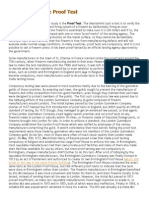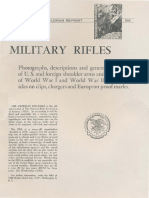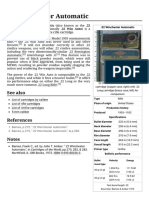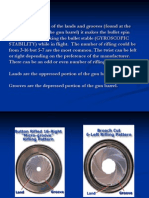M1895 Colt-Browning Machine Gun
M1895 Colt-Browning Machine Gun
Uploaded by
blowmeasshole1911Copyright:
Available Formats
M1895 Colt-Browning Machine Gun
M1895 Colt-Browning Machine Gun
Uploaded by
blowmeasshole1911Original Description:
Copyright
Available Formats
Share this document
Did you find this document useful?
Is this content inappropriate?
Copyright:
Available Formats
M1895 Colt-Browning Machine Gun
M1895 Colt-Browning Machine Gun
Uploaded by
blowmeasshole1911Copyright:
Available Formats
M1895 Colt-Browning machine gun
M1895 Colt-Browning machine gun
Colt Browning M1895/14 Machine Gun in 7mm Mauser caliber, possibly used in the Mexican Revolution. Type Place of origin Machine gun United States Service history Used by See Users Production history Designer Designed Manufacturer John M. Browning 1889-1895 Colt Marlin Rockwell Specifications Weight Length Barrel length 16kg 1040mm 711mm
Cartridge
6mm Lee Navy 7x57mm Mauser .30-40 Krag
.30-06 Springfield .303 British 7.62x54mmR Action Rate of fire Feed system Sights Gas, lever actuated 400rpm Belt Iron
The Colt-Browning M1895, nicknamed potato digger due to its unusual operating mechanism, is an air-cooled, belt-fed, gas-operated machine gun that fires from a closed bolt with a cyclic rate of 450 rounds per minute. Based on a John Moses Browning design dating to 1889, it was the first successful gas-operated machine gun to enter service.[1][2][3]
Operating mechanism
Filed for patent in 1892, the M1895's operating mechanism was one of Browning's early patents for automatic rifles;[4][5] he had previously been working on lever action rifles for Winchester such as the Winchester 1886. The M1895 uses a unique operating mechanism, which is quite similar to that of a lever-action rifle. The earliest prototype developed by Browning in early 1889 was a .44 caliber black powder cartridge rifle, weighing under 12 pounds. Operation was via a lever located under the barrel, which operated the action when swung downwards. The lever was actuated by the muzzle blast operating upon it.[2]
Development
M1895 operating mechanism showing the lever in the forward (top) and rear (bottom) positions An improved design based on Browning's prototype lever mechanism was offered to Colt by Browning in 1892. The lever was moved back, and power was supplied by a gas port about six inches (15 cm) back from the muzzle. To minimize heating during rapid fire, the gun used a very heavy straight countor barrel (finned for ventilation on later variants), bringing its weight up to 35 pounds; the standard tripod mount with seat for the gunner, added another 56 pounds. Despite the heavy barrel, the closed bolt mechanism would cook off shots if a round was left chambered in a hot barrel. This required that the gun be unloaded immediately after an extended burst of firing. [2] During testing of the gun, it was found to be capable of firing extended bursts of over 1000 rounds before the barrel overheated and bullets began to tumble out of control; upon stopping, the red-hot barrel cooked off four or five additional shots before cooling down.[6]
The gun was originally chambered in 6 mm Lee Navy and later, after the adoption of the KragJorgensen rifle, in .30-40 Krag, 7x57mm Mauser caliber (the same cartridge used in the Spanish Model 1893 Mauser), and .30-06 Springfield in 1914. The 1914 version also included a lower tripod for firing prone; this is likely what led to the gun's nickname of "potato digger", as the operating lever would dig into the ground if it were fired from too low a position.[7] The M1895 was made for export as well; the Russians ordered several thousand M1895 machine guns in 1914 in 7.62 x 54R caliber for use in World War I. In .303 British caliber, the M1895/14 saw service in England and France. The M1895 was also sold in 7x57mm Mauser caliber for use by various countries in South America.[3] The Colt's unusual method of operation had both advantages and disadvantages compared to competing machine gun designs of the day. The lever-operated repeating action gave the weapon a relatively slow rate of fire (less than 400 rounds a minute). However, the slow rate of fire combined with a heavy barrel also allowed the gun to be air-cooled, resulting in a simpler, lighter, and more portable machine gun compared to water-cooled designs. Though combat reports of action stoppages were not uncommon, most of these could be overcome by manually cycling the action. As gunners gained experience with operating an air-cooled machine gun, it became apparent that avoiding long continuous periods of fire materially added to the weapon's reliability and barrel life.
Use
The M1895 was the first machine gun adopted by the United States military, and it saw service with the Army (who never formally adopted it), and the US Navy/US Marines, and was adapted to use in many roles. It was mounted on tripods, horse drawn carriages, boats, aircraft, and even armored cars. The US Navy was the first to begin testing, as early as 1893, with a version chambered in the Navy's 6mm cartridge.[8][9]
Early conflicts
U.S. Marines pose with a belt of 6 millimeter ammunition for the M1895 Colt, c. 1910. The photo shows two types of mounts, the early model tripod and the high wheeled gun carriage.
Polish soldiers with the M1895/14 during the Battle of Warsaw
In 6mm Lee Navy caliber, the M1895 saw service with the United States Marines during the Spanish American War, including the 1898 invasion of Guantanamo Bay, where a Marine battalion deployed four Colt guns (two of them borrowed from the USS Texas ship's armory).[10] The M1895 proved to be a significant advance in firepower for the Marines, who employed them in the first known use of machine guns by the American military to provide tactical support of infantry forces during an assault. In contrast, Army regular forces in the campaign were still burdened with heavy, manually operated Gatling guns that required heavy artillery carriages pulled by mule transport. Roosevelt's Rough Riders, a dismounted volunteer cavalry regiment that fought in Cuba, also deployed two M1895 Colt machine guns in 7 x 57mm Mauser caliber (built for export, both guns were privately purchased for the Rough Riders), but although they did cause some Spanish casualties were reportedly somewhat unreliable. As Col. Roosevelt noted, "These Colt automatic guns were not, on the whole, very successful...they proved more delicate than the Gatlings, and very readily got out of order."[11] The two M1895 guns were transferred to Lt. John Parker's Gatling Gun Detachment, who used them in the siege of Santiago.[12] The M1895 in 6mm Lee was also utilized by American Naval and Marine forces during the Philippine American War, and the Boxer Rebellion, where it proved to be accurate and reliable.[13] Around 1904 the Mexican government purchased 150 of these guns in 7mm Mauser caliber, and these guns were employed throughout the protracted Mexican Revolution.[14][15] Use of the 7mm M1895 in the Mexican Revolution has been photographically documented, including the use of the gun by what appears to be a Villista. The US Navy also deployed some 6mm Lee M1895 guns from ship armories during the 1914 Vera Cruz fighting and occupation. The US Army, while never formally adopting the M1895, purchased 2 guns in 1902, followed by an additional purchase of 140 guns in 1904. These guns, along with small quantities of Maxim and Vickers guns, were issued to various units for evaluation purposes. These would see intermittent use by Army and National Guard Units at least until 1921. The first formally adopted machine gun by the US Army was the M1909 Benet-Mercie (Hotchkiss) machine-rifle, a bipod-mounted, strip-feed machine gun. Further south, the M1895 was also used by the Uruguayan Army against rebels during a late flare-up of the Uruguayan Civil War in 1904. Canadian mounted troops successfully used .303 M1895 guns in the Second Boer War (1899 1902). In one spectacular rear guard action a Colt gun mounted on a light carriage was able to stop a
pursuing Boer Cavalry unit. The Canadian success with the M1895 led to the further use of the gun by the Canadian Army in World War I. The M1895 was also used by various U.S. state militia and guard units, including the Colorado national guard. A few of these guns fell into the hands of private militias staffed by mine company guards after the state discontinued funding of most of the guard units assigned to maintain order during a prolonged miners' strike. In 1914, an emplaced "digger" of one of these private militias fired extensively into a miner camp in Ludlow, Colorado, an event later termed the Ludlow Massacre. A privately purchased M1895 also provided the main armament of an armored car of the Baldwin-Felts Detective Agency used to terrorize miners' camps during the strike, which the miners called the Death Special.
World War I
The M1895/14 Colt-Browning saw use in France by some Canadian infantry formations. Deploying to France in 1915, the 21st Canadian Light Infantry Battalion used .303-caliber M1895/14 machine guns in combat. These guns saw significant combat but were soon replaced by Vickers machine guns. They were not taken out of combat however, but were instead given to equip formations of the Belgian Exile Army. The French also tested the Colt and some were used in early aircraft for testing. Additional Colt guns were sent to the Russians, who used them extensively. The Italian navy also used the Colts (and later Marlin production guns) for their navy. As many as four were mounted on each Italian torpedo boat. While the United States used the M1895 for training, it was considered obsolete by the point the United States entered the war, and saw no service. Colt ceased production of the M1895 and variants in 1916, selling the machinery and rights to manufacture to Marlin Rockwell who took over the still active Russian military and Italian Navy contracts in order to concentrate on increased Vickers production. After Marlin started making the Colt 1914's, it developed an improved version of the M1895 was designed and produced by Marlin Rockwell (currently Marlin Firearms) in 1917 and it was adopted by the US Army as a training weapon and approximately 2500 were purchased. This improved gun, the Colt-Browning M1895/14, was also called the "Marlin Gun" and "Model 1917". The primary improvement was the use of a detachable barrel, a more generous side plate cut-out and a sliding door on the right side plate opening (also made larger) for easier access. Despite these improvements, the Marlin was limited to 500 rounds of continuous fire due to a tendency to overheat. The Navy also purchased a version of the Marlin gun with a gas piston in lieu of the lever mechanism, although very few if any guns saw service aboard ship. A second, much more radical version of the M1895 was introduced in 1917 for tank and aircraft use, later designated the Marlin M1917 and M1918. Like the Navy Marlins, these variants used a linear gas piston in place of the 'potato digger' arm and bore little outward physical resemblance to the basic "digger" design. The new reciprocating piston was located parallel to the barrel and below it, allowing the gun to be mounted lower to the ground. Another improvement was the use of aluminum fins as a heat radiator. Most Marlin M1917 and M1918 guns saw use in aircraft as defensive armament. By the last months of World War I, almost 50% of the Spad XIII fighter aircraft in France had their Vickers guns replaced with Marlins. Had the war progressed into 1919 the Marlin would have been the primary U.S. tank and aircraft gun. The M1917/1918 also equipped Thomas Morse Scout aircraft used for advanced training at stateside bases.
The Marlin gun would see postwar use on the machine gun version of US Army's Six Ton Tank, an American copy of the French FT-17. However, the Marlin guns quickly disappeared from U.S. military service after the great success of the .30 Browning machine guns and variants subsequently adopted for air, ground, and shipboard use.
Postwar Service
After World War I, some Colt-Browning guns (possibly including the M1917/18 Marlin variants) saw use in the Russian Civil war. Its most spectacular use came during the Czech Legion's exodus from Russia, where the guns (either Colt-Browning M1914 or Marlin M1917 models) were photographed in sandbagged stations on the top of trains being used to transport the Legion as it withdrew from Soviet Russia. Many of these guns were also used in the Russo-Finnish war of 1920. At the outset of World War II, M1917 and M1918 Marlins were also sent to Britain for use by the Home Guard, but were never actually employed in combat. The last documented use of the type was by the National Guard against striking miners in the Battle of Blair Mountain, West Virginia in 1921. A contemporary photo illustrates a Colt-Browning gun with a ribbed barrel in the hands of a guardsman supporting Sheriff's deputies. The ventilating ribs indicate the gun was most likely a Marlin M1917/18 machine Gun purchased by the Army in 1917-18 for training and familiarization purposes, as the U.S. military never purchased the Colt M1895/1914 variant. The Belgian army acquired a large number of 7mm Mauser M1895/14 versions towards the end of World War I, which were kept in storage after the conflict and allocated to certain reserve infantry regiments before the outbreak of World War II. The guns were widely used in action during the German invasion of Belgium between 10th May and 28th May 1940.
Users
Belgium Canada Czechoslovakia France Kingdom of Italy Poland Russian Empire Uruguay United Kingdom United States
References
1. ^ http://world.guns.ru/machine/usa/colt-browning-m195-e.html 2. ^ a b c Julian S. Hatcher (1962). Hatcher's Notebook. Stackpole Books. pp. 7981. ISBN 0811707954. 3. ^ a b United States Army. Ordnance Dept, Herbert Treadwell Wade (1919). Handbook of Ordnance Data. p. 307. 4. ^ US 544657
5. ^ Wilson, Mike. "John Browning's Patent Numbers". http://funarg.nfshost.com/r2/notes/browning-patents.html. Retrieved 2009-05-22. 6. ^ United States War Dept (1904). Annual Reports of the War Department. Govt. Print. Office. pp. 8392. 7. ^ Roger Pauly (2004). Firearms: The Life Story of a Technology. Greenwood Publishing Group. ISBN 9780313327964. 8. ^ "Browning Machine Guns". http://browningmgs.com/Images_1919A4/Brownings.htm. 9. ^ United States Navy Dept. (1893). Annual Reports of the Navy Department: Report of the Secretary of the Navy. Published by United States Government Printing Office. p. 235. 10. ^ Venzon, Anne, General Smedley Darlington Butler: Letters of a Leatherneck 1898-1931, Greenwood Publishing Co, (1992), ISBN 0-275-94141-8, p. 8: The battleship USS Texas landed three field pieces and two additional M1895 Colt-Browning machine guns on June 12, the latter procured from the ship's own armory. 11. ^ Roosevelt, Theodore, The Rough Riders, Scribner's Magazine, Vol. 25, February 1899, New York: Charles Scribner's Sons, p. 568 12. ^ Parker, John H. (Lt.), The Gatlings At Santiago, Middlesex, U.K.: Echo Library (reprinted 2006), p. 68: At Lt. Parker's order, the Detachment secured about 10,000 additional rounds of captured Spanish 7mm Mauser ammunition, which allowed the gun crew to keep the two M1895 guns in action. 13. ^ Joseph H. Alexander, Don Horan, Norman C. Stahl (1999). The Battle History of the U.S. Marines: A Fellowship of Valor. HarperCollins. p. 26. ISBN 9780060931094. 14. ^ Philip S. Jowett, A. M. De Quesada, Stephen Walsh (2006). The Mexican Revolution 191020. Osprey Publishing. ISBN 9781841769899. 15. ^ "THE WEAPONS COLLECTION". REME MUSEUM of TECHNOLOGY. http://www.rememuseum.org.uk/arms/machguns/armmg1.htm#124.
External links
Profile of M1895 usage in Spanish-American War
You might also like
- Mechanical & Electronic FuzeDocument349 pagesMechanical & Electronic FuzeVikas Chandra89% (44)
- Building The SGN-22 (Single-Shot Rifle Build)Document25 pagesBuilding The SGN-22 (Single-Shot Rifle Build)blowmeasshole191157% (7)
- All Cards Warfighter WW2Document3,216 pagesAll Cards Warfighter WW2Ogami2002No ratings yet
- Model 1897 Pump Shotgun: Instruction ManualDocument5 pagesModel 1897 Pump Shotgun: Instruction ManualGhiles Oucherif100% (2)
- Notes On The Proof On Shotguns Other Small ArmsDocument17 pagesNotes On The Proof On Shotguns Other Small ArmsThomas James AttreeNo ratings yet
- SAAMI ITEM 211-Unsafe Arms and Ammunition CombinationsDocument14 pagesSAAMI ITEM 211-Unsafe Arms and Ammunition CombinationsMB-RP100% (1)
- Ballistic FormulasDocument26 pagesBallistic Formulasblowmeasshole1911100% (5)
- Compression Springs: Compression Spring Design General ConsiderationsDocument15 pagesCompression Springs: Compression Spring Design General Considerationsblowmeasshole1911100% (1)
- Heckler & Kock HK MP7A1 Submachine Gun (Germany) 8Document2 pagesHeckler & Kock HK MP7A1 Submachine Gun (Germany) 8blowmeasshole1911100% (2)
- 75mm M3 GunDocument2 pages75mm M3 Gunjdnwotc100% (1)
- Gunmart 2018 - 10Document252 pagesGunmart 2018 - 10vpetrisorNo ratings yet
- Colt-Browning Model 1895 Machine Gun (Potato Digger)Document7 pagesColt-Browning Model 1895 Machine Gun (Potato Digger)blowmeasshole1911No ratings yet
- The Book of Gun Trivia: Essential Firepower FactsFrom EverandThe Book of Gun Trivia: Essential Firepower FactsRating: 3.5 out of 5 stars3.5/5 (4)
- Toward A 600 M GP RoundDocument39 pagesToward A 600 M GP RoundJuan Luis Chulilla CanoNo ratings yet
- Bayonets For The Peabody-Martini Rifle PDFDocument31 pagesBayonets For The Peabody-Martini Rifle PDFtabeli holoNo ratings yet
- For The Toughest Hunts and The Toughest Hunters, It's Just A Better GunDocument15 pagesFor The Toughest Hunts and The Toughest Hunters, It's Just A Better GunJeremi LeeNo ratings yet
- Reloading Bulged Pistol Brass-Rev2Document10 pagesReloading Bulged Pistol Brass-Rev2Brian RobinsonNo ratings yet
- Browning Auto-5 ShotgunDocument6 pagesBrowning Auto-5 Shotgunblowmeasshole1911100% (1)
- Testing Firearms - Proof TestDocument8 pagesTesting Firearms - Proof Testblowmeasshole1911No ratings yet
- TM Ma1-1 Ruger Ac-556Document14 pagesTM Ma1-1 Ruger Ac-556dacarilloNo ratings yet
- 7.92×57mm MauserDocument12 pages7.92×57mm MauserGiulio VerrecchiaNo ratings yet
- The Harrington & Richardson M4 Survival RifleDocument2 pagesThe Harrington & Richardson M4 Survival Rifleblowmeasshole1911No ratings yet
- US Model Surplus Military Rifles PDFDocument25 pagesUS Model Surplus Military Rifles PDFtabeli holo100% (1)
- Armory CatalogDocument17 pagesArmory Catalogshades_o_greyNo ratings yet
- Beretta - Sako 2015 Rifle Product GuideDocument31 pagesBeretta - Sako 2015 Rifle Product Guideqcqapgh7748No ratings yet
- Beretta 2011 USAExport CatalogDocument34 pagesBeretta 2011 USAExport Catalogrcatalin_20No ratings yet
- Owners Manual: For 500, 505, 535, 590 and 835 Models Pump Action ShotgunsDocument32 pagesOwners Manual: For 500, 505, 535, 590 and 835 Models Pump Action ShotgunsnijazzoljNo ratings yet
- 2016 Colt Commercial Price ListDocument8 pages2016 Colt Commercial Price ListKaran ShandilyaNo ratings yet
- ALW Brochure Ammo LoadDocument9 pagesALW Brochure Ammo LoadandreibaggiNo ratings yet
- .22 Winchester Automatic - Wikipedia PDFDocument2 pages.22 Winchester Automatic - Wikipedia PDFAce ActionNo ratings yet
- Hornady 2017 Product CatalogDocument132 pagesHornady 2017 Product CatalogPeter DavidsonNo ratings yet
- Ruger P345Document40 pagesRuger P345Judge FudgeNo ratings yet
- 9×25mm Dillon: History Cartridge Dimensions Reloading Commercial Availability See Also References External LinksDocument4 pages9×25mm Dillon: History Cartridge Dimensions Reloading Commercial Availability See Also References External Linkstyrant88No ratings yet
- 2010 Uberti CatalogDocument24 pages2010 Uberti CatalogMario Lopez100% (1)
- Model 1894 Sights: WinchesterDocument34 pagesModel 1894 Sights: WinchesterMárcio MontenegroNo ratings yet
- 19th Century Carbine Manual 1Document35 pages19th Century Carbine Manual 1GustavNo ratings yet
- 7mm Rem Mag Ballistics Chart & Coefficient PDFDocument1 page7mm Rem Mag Ballistics Chart & Coefficient PDFRobert StackNo ratings yet
- CQC Online ManualDocument14 pagesCQC Online Manualnabeelmerchant01No ratings yet
- Mauser M03 Manual enDocument11 pagesMauser M03 Manual enbuggubNo ratings yet
- Crosman Model Series 761XLDocument6 pagesCrosman Model Series 761XLjayNo ratings yet
- Sti 2011Document34 pagesSti 2011preceptiveinquirer100% (1)
- Operation and Safety ManualDocument40 pagesOperation and Safety ManualMarshallNo ratings yet
- m1 Garand Manual 2018Document15 pagesm1 Garand Manual 2018MarioNo ratings yet
- W k98 PDFDocument14 pagesW k98 PDFjack maikaNo ratings yet
- m14 Maintenance 1 PDFDocument4 pagesm14 Maintenance 1 PDFentomophileNo ratings yet
- Enfield Snider - A Brief Outline of The SystemDocument3 pagesEnfield Snider - A Brief Outline of The Systemblowmeasshole1911No ratings yet
- The 5.56 X 45mm - 1990 - 1994 - A Chronology of Development (Part 11) - by Daniel WattersDocument23 pagesThe 5.56 X 45mm - 1990 - 1994 - A Chronology of Development (Part 11) - by Daniel Wattersblowmeasshole1911No ratings yet
- Bullettest Tube ArticleDocument3 pagesBullettest Tube ArticleRedmund Tj HinagdananNo ratings yet
- 22-250 Remington 223 Remington: C.O.A.L. 2.635" C.O.A.L. 2.440"Document4 pages22-250 Remington 223 Remington: C.O.A.L. 2.635" C.O.A.L. 2.440"Pierre MoellerNo ratings yet
- Kar 98Document6 pagesKar 98greaternorthroad8820No ratings yet
- Savage MKII Bolt Action RimfireDocument38 pagesSavage MKII Bolt Action RimfireCarl J. Wilkey100% (1)
- Historic FirearmsDocument22 pagesHistoric FirearmsAbilio Antonio De AraujoNo ratings yet
- Benelli B76 US3893369Document4 pagesBenelli B76 US3893369apoorva singhNo ratings yet
- SchatzDocument175 pagesSchatzHPFlashman100% (1)
- Updated AMMO-Details LatestDocument8 pagesUpdated AMMO-Details LatestjibranNo ratings yet
- Armalite AR-5 RifleDocument3 pagesArmalite AR-5 Rifleblowmeasshole1911No ratings yet
- Gun World - June 2016Document100 pagesGun World - June 2016gabrielabarberio.aleNo ratings yet
- Gun Trader's Guide, Thirty-Fifth Edition: A Comprehensive, Fully Illustrated Guide to Modern Firearms with Current Market ValuesFrom EverandGun Trader's Guide, Thirty-Fifth Edition: A Comprehensive, Fully Illustrated Guide to Modern Firearms with Current Market ValuesNo ratings yet
- Remington Country July 2014Document46 pagesRemington Country July 2014AmmoLand Shooting Sports NewsNo ratings yet
- Hotchkiss 13.2mm Machine Gun - Wiki2Document4 pagesHotchkiss 13.2mm Machine Gun - Wiki2blowmeasshole1911No ratings yet
- Proof MarksDocument6 pagesProof MarksWalter Julius Kuleck0% (1)
- Punching Holes: Buying Ammunition, Gun Accessories, Knives and Tactical Gear at Wholesale PricesFrom EverandPunching Holes: Buying Ammunition, Gun Accessories, Knives and Tactical Gear at Wholesale PricesNo ratings yet
- Varmint Rifles and Cartridges: A Comprehensive Evaluation of Select Guns and LoadsFrom EverandVarmint Rifles and Cartridges: A Comprehensive Evaluation of Select Guns and LoadsNo ratings yet
- A New Rule For Estimating Rifling Twist ... by Don MillerDocument8 pagesA New Rule For Estimating Rifling Twist ... by Don Millerblowmeasshole1911No ratings yet
- Kobe 97Document18 pagesKobe 97hbbbuttNo ratings yet
- Compression-Spring Design ExampleDocument5 pagesCompression-Spring Design Examplestphn_maturinNo ratings yet
- An Introduction To Air Density and Density Altitude CalculationsDocument28 pagesAn Introduction To Air Density and Density Altitude Calculationsblowmeasshole1911No ratings yet
- Belleville Washers: Common ApplicationsDocument5 pagesBelleville Washers: Common Applicationsblowmeasshole1911No ratings yet
- Constant Force SpringsDocument4 pagesConstant Force Springsblowmeasshole1911No ratings yet
- Heckler Und Koch UMP (Germany) 5Document2 pagesHeckler Und Koch UMP (Germany) 5blowmeasshole1911100% (2)
- Heckler Und Koch MP-5k Submachine Gun (Germany)Document5 pagesHeckler Und Koch MP-5k Submachine Gun (Germany)blowmeasshole1911100% (3)
- Heckler and Koch MP-5 Submachine Gun (Germany) 1Document6 pagesHeckler and Koch MP-5 Submachine Gun (Germany) 1blowmeasshole1911100% (2)
- Armalite AR-30 Bolt-Action RifleDocument3 pagesArmalite AR-30 Bolt-Action Rifleblowmeasshole1911100% (2)
- Hotchkiss M1914 Machine GunDocument6 pagesHotchkiss M1914 Machine Gunblowmeasshole1911No ratings yet
- Hotchkiss M1922 Machine Gun - Wiki7Document3 pagesHotchkiss M1922 Machine Gun - Wiki7blowmeasshole1911No ratings yet
- DUX Model 1953 and 1959 Submachine Gun (Germany-Spain) 3Document2 pagesDUX Model 1953 and 1959 Submachine Gun (Germany-Spain) 3blowmeasshole1911100% (1)
- Reibel Machine Gun (France)Document4 pagesReibel Machine Gun (France)blowmeasshole1911No ratings yet
- Lebel Model 1886 Bolt-Action Rifle (France)Document9 pagesLebel Model 1886 Bolt-Action Rifle (France)blowmeasshole1911No ratings yet
- Hotchkiss 13.2mm Machine Gun - Wiki2Document4 pagesHotchkiss 13.2mm Machine Gun - Wiki2blowmeasshole1911No ratings yet
- Armalite AR-5 RifleDocument3 pagesArmalite AR-5 Rifleblowmeasshole1911No ratings yet
- Armalite AR-50 Bolt-Action RifleDocument4 pagesArmalite AR-50 Bolt-Action Rifleblowmeasshole1911No ratings yet
- Armalite AR-7 RifleDocument6 pagesArmalite AR-7 Rifleblowmeasshole1911No ratings yet
- Armalite AR-16 Battle RifleDocument3 pagesArmalite AR-16 Battle Rifleblowmeasshole1911No ratings yet
- FM 24-29 Light Machine Gun (France)Document5 pagesFM 24-29 Light Machine Gun (France)blowmeasshole1911100% (1)
- St. Etienne Mle 1907 (Light Machine Gun)Document4 pagesSt. Etienne Mle 1907 (Light Machine Gun)blowmeasshole1911No ratings yet
- World War II Weapons - The Colt .45 Revolver (M1917)Document1 pageWorld War II Weapons - The Colt .45 Revolver (M1917)blowmeasshole1911100% (1)
- US Revolver Models (Colt) 1889, 1892, 1894, 1895 and 1896 by David VelleuzDocument3 pagesUS Revolver Models (Colt) 1889, 1892, 1894, 1895 and 1896 by David Velleuzblowmeasshole1911No ratings yet
- Hotchkiss Portative - Hotchkiss .303 Portable Mk. 1 Machine Gun - Benet-Mercie Machine Rifle M1909Document3 pagesHotchkiss Portative - Hotchkiss .303 Portable Mk. 1 Machine Gun - Benet-Mercie Machine Rifle M1909blowmeasshole1911No ratings yet
- Hotchkiss Model 1922 Light Machine Gun (France)Document2 pagesHotchkiss Model 1922 Light Machine Gun (France)blowmeasshole1911No ratings yet
- Catalog On The AR-15 RifleDocument100 pagesCatalog On The AR-15 RifleBergerudR100% (1)
- BSG Combat Weapons Instructor SmartbookDocument152 pagesBSG Combat Weapons Instructor Smartbookbsgcombatweapons100% (3)
- Weapons: Single Action RevolversDocument6 pagesWeapons: Single Action RevolversSklam PotNo ratings yet
- Composite Tube For Gun BarrelDocument12 pagesComposite Tube For Gun Barrelibrahim sugarNo ratings yet
- Gun Letter by Gov. MalloyDocument1 pageGun Letter by Gov. MalloyEditor, Hartford CourantNo ratings yet
- IOF .32 Revolver: HuntingDocument5 pagesIOF .32 Revolver: HuntingMe AnNo ratings yet
- Notice of No Longer in Possession: Please Type or PrintDocument3 pagesNotice of No Longer in Possession: Please Type or PrintNocti VltkNo ratings yet
- m14 Maintenance 1 PDFDocument4 pagesm14 Maintenance 1 PDFentomophileNo ratings yet
- War Machine 2Document24 pagesWar Machine 2wfrad90% (10)
- Yperion's 55 Trick ArrowsDocument15 pagesYperion's 55 Trick ArrowsPedro Squirtle100% (2)
- International Catalogue & Pricelist: Shooting Sport TargetsDocument64 pagesInternational Catalogue & Pricelist: Shooting Sport TargetsYukio ShirakawaNo ratings yet
- AR - May 2016Document134 pagesAR - May 2016Dennis ShongiNo ratings yet
- M203 + M79 - 40mm Grenade Launcher + AmmunitionDocument73 pagesM203 + M79 - 40mm Grenade Launcher + Ammunitionhodhodhodsribd100% (2)
- Chapter ViiiDocument13 pagesChapter ViiiBrielle Shai CruzNo ratings yet
- Adeptus Arbites v1.2Document14 pagesAdeptus Arbites v1.2joge jdkiNo ratings yet
- Firearm Safety Cert PrepDocument51 pagesFirearm Safety Cert Preppolebear100% (2)
- Compiled TablesDocument48 pagesCompiled TablesFabricio Moreira100% (2)
- AP BulletsDocument11 pagesAP BulletsTuan NguyenNo ratings yet
- Wilson-Dunham MissileThreat 20200826 0Document27 pagesWilson-Dunham MissileThreat 20200826 0adnan gondžićNo ratings yet
- 500 SW Magnum FTXDocument1 page500 SW Magnum FTXMichael RoblesNo ratings yet
- Lesson 2 Firearms and Ammunition: TH THDocument19 pagesLesson 2 Firearms and Ammunition: TH THBAMBILLA, LYNDON I.No ratings yet
- Rulebook Zombicide 2nd Edition PDFDocument68 pagesRulebook Zombicide 2nd Edition PDFRejane100% (2)
- Raven Eu17 GBB Pistol Patrol Base UkDocument1 pageRaven Eu17 GBB Pistol Patrol Base Ukoloveder.2509No ratings yet
- 04 Firearms InstructorDocument2 pages04 Firearms InstructorCristian ButaNo ratings yet
- FirearmDocument49 pagesFirearmRean Dadia Giray100% (1)
- Arrow Making Guide.: Proper Arrows Are EssentialDocument29 pagesArrow Making Guide.: Proper Arrows Are EssentialEdgars MurnieksNo ratings yet




















































































































